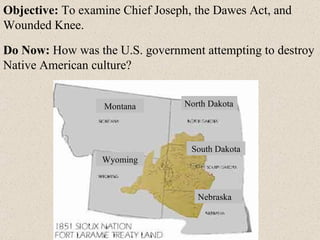
Chief Joseph, Wounded Knee, Dawes Act
- 1. Objective: To examine Chief Joseph, the Dawes Act, and Wounded Knee. Do Now: How was the U.S. government attempting to destroy Native American culture? Montana North Dakota Wyoming South Dakota Nebraska
- 4. … fear of the Indians continued as late as the 1890's. The Buffalo Echo joined the hysteria which swept parts of the west in 1890 relating to the "Ghost Dance." The entire issue was based on conversations with a lady who was passing through by stage and who had no first hand knowledge, but was merely repeating what she had heard.
- 5. Ghost Dance of the Oglala Sioux, Harper's Weekly, December 1890.
- 6. · The Lakota tribe was brought to Wounded Knee Creek, SD, by the army and disarmed. Wounded Knee
- 8. View of the slain frozen body of a Native American Lakota Sioux medicine man on the battlefield at the site of the Wounded Knee Massacre, Wounded Knee Creek, Pine Ridge Reservation, South Dakota. The body has clenched arms and is posed with a rifle. (Jan.3, 1891)
- 9. · From 300-400 Lakota men, women and children were killed, as well as approximately 30 soldiers. Lakota Sioux witness American Horse: “ A mother was shot down with her infant; the child not knowing that its mother was dead was still nursing... The women as they were fleeing with their babies were killed together... and after most of them had been killed a cry was made that all those who were not killed or wounded should come forth and they would be safe. Little boys... came out of their places of refuge, and as soon as they came in sight a number of soldiers surrounded them and butchered them there.”
- 10. A civilian burial party and U.S. Army officers pose over a mass grave trench with bodies of Native American Lakota Sioux killed at Wounded Knee, Pine Ridge Reservation, South Dakota. (January 3, 1891)
- 11. Chief Joseph · The Nez Percés tribe was ordered onto a reservation in Idaho. · Chief Joseph refused and fled with his tribe.
- 12. “ You might as well expect all rivers to run backward as that any man who was born a free man should be contented penned up and denied liberty to go where he pleases. If you tie a horse to a stake, do you expect he will grow fat? If you pen an Indian up on a small spot of earth and compel him to stay there, he will not be contented nor will he grow and prosper. I have asked some of the Great White Chiefs where they get their authority to say to the Indian that he shall stay in one place, while he sees white men going where they please. They cannot tell me.
- 13. Whenever the white man treats the Indian as they treat each other then we shall have no more wars. We shall be all alike -- brothers of one father and mother, with one sky above us and one country around us and one government for all.” – Chief Joseph, Washington, D.C., 1879 Let me be a free man, free to travel, free to stop, free to work, free to trade where I choose, free to choose my own teachers, free to follow the religion of my fathers, free to talk, think and act for myself -- and I will obey every law or submit to the penalty.
- 14. · Chief Joseph became known for his eloquent quotations on the plight of the Native Americans. “ It is cold, and we have not blankets. The children are freezing to death…"Hear me, my chiefs! I am tired. My heart is sick and sad. From where the sun now stands, I will fight no more forever." - Chief Joseph · Soldiers caught up to the tribe and forced them to surrender .
- 15. 5. Finally, American citizenship was granted to Native Americans who accepted their land, lived apart from the tribe, and adopted the habits of "civilized life." Terms of the Dawes Act 1. Divided tribal lands into small plots for distribution among members of the tribe. 2. Each family head received 160 acres. 3. Once land was distributed to Native Americans, any surplus was sold to white settlers with the profits of those sales going to Native American schools. 4. To keep the Native Americans' land from falling into the hands of speculators, the federal government held it in trust for 25 years.
- 16. * This went against the culture of the Plains Indians and opened up the Indian Territory for American settlement. Dawes Act (1887) · The Dawes Act encouraged Native Americans to become farmers . · Native American land would be divided up among individual families.
